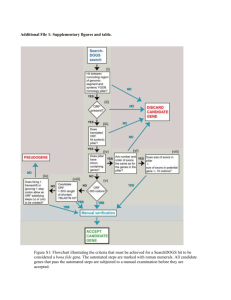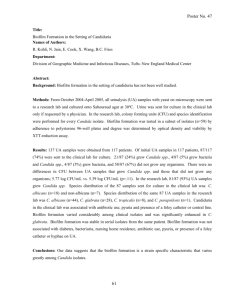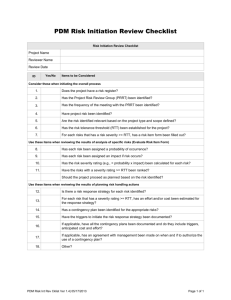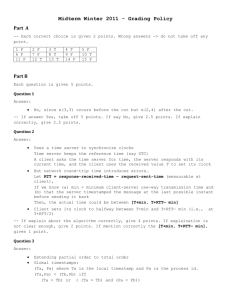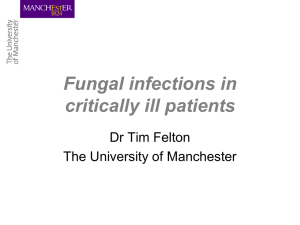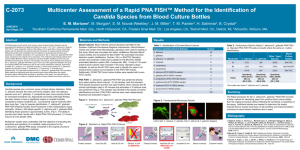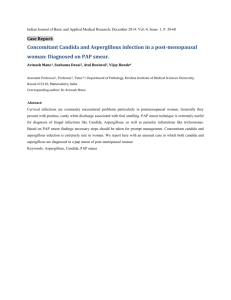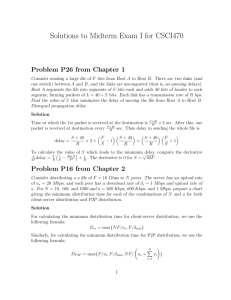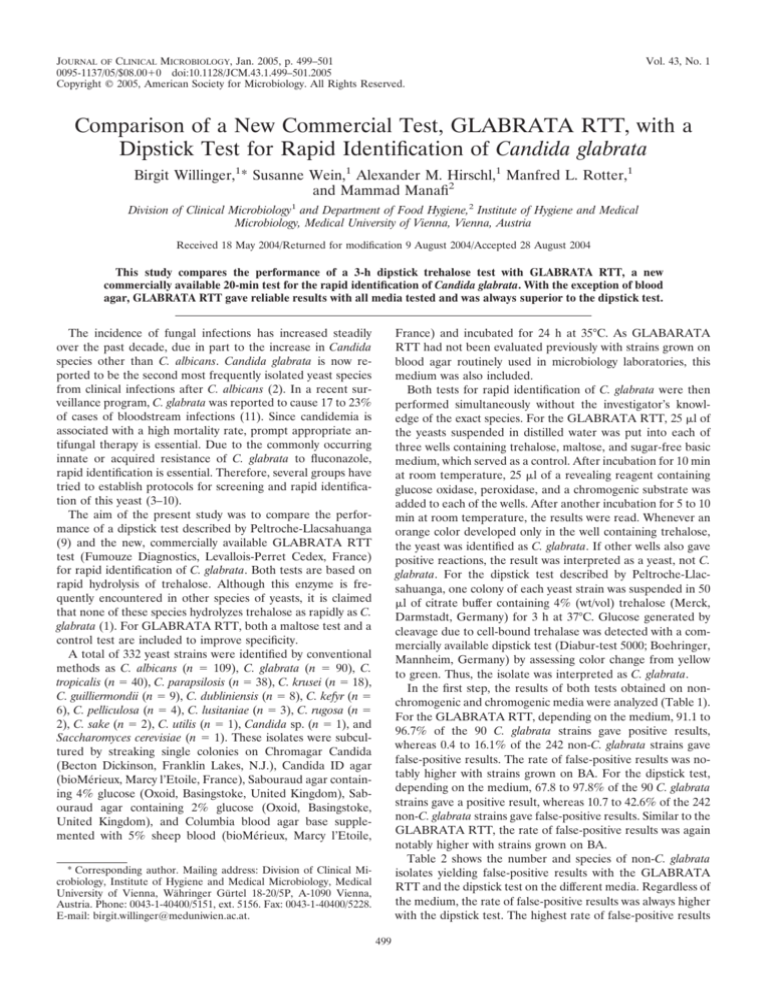
JOURNAL OF CLINICAL MICROBIOLOGY, Jan. 2005, p. 499–501
0095-1137/05/$08.00⫹0 doi:10.1128/JCM.43.1.499–501.2005
Copyright © 2005, American Society for Microbiology. All Rights Reserved.
Vol. 43, No. 1
Comparison of a New Commercial Test, GLABRATA RTT, with a
Dipstick Test for Rapid Identification of Candida glabrata
Birgit Willinger,1* Susanne Wein,1 Alexander M. Hirschl,1 Manfred L. Rotter,1
and Mammad Manafi2
Division of Clinical Microbiology1 and Department of Food Hygiene,2 Institute of Hygiene and Medical
Microbiology, Medical University of Vienna, Vienna, Austria
Received 18 May 2004/Returned for modification 9 August 2004/Accepted 28 August 2004
This study compares the performance of a 3-h dipstick trehalose test with GLABRATA RTT, a new
commercially available 20-min test for the rapid identification of Candida glabrata. With the exception of blood
agar, GLABRATA RTT gave reliable results with all media tested and was always superior to the dipstick test.
France) and incubated for 24 h at 35°C. As GLABARATA
RTT had not been evaluated previously with strains grown on
blood agar routinely used in microbiology laboratories, this
medium was also included.
Both tests for rapid identification of C. glabrata were then
performed simultaneously without the investigator’s knowledge of the exact species. For the GLABRATA RTT, 25 l of
the yeasts suspended in distilled water was put into each of
three wells containing trehalose, maltose, and sugar-free basic
medium, which served as a control. After incubation for 10 min
at room temperature, 25 l of a revealing reagent containing
glucose oxidase, peroxidase, and a chromogenic substrate was
added to each of the wells. After another incubation for 5 to 10
min at room temperature, the results were read. Whenever an
orange color developed only in the well containing trehalose,
the yeast was identified as C. glabrata. If other wells also gave
positive reactions, the result was interpreted as a yeast, not C.
glabrata. For the dipstick test described by Peltroche-Llacsahuanga, one colony of each yeast strain was suspended in 50
l of citrate buffer containing 4% (wt/vol) trehalose (Merck,
Darmstadt, Germany) for 3 h at 37°C. Glucose generated by
cleavage due to cell-bound trehalase was detected with a commercially available dipstick test (Diabur-test 5000; Boehringer,
Mannheim, Germany) by assessing color change from yellow
to green. Thus, the isolate was interpreted as C. glabrata.
In the first step, the results of both tests obtained on nonchromogenic and chromogenic media were analyzed (Table 1).
For the GLABRATA RTT, depending on the medium, 91.1 to
96.7% of the 90 C. glabrata strains gave positive results,
whereas 0.4 to 16.1% of the 242 non-C. glabrata strains gave
false-positive results. The rate of false-positive results was notably higher with strains grown on BA. For the dipstick test,
depending on the medium, 67.8 to 97.8% of the 90 C. glabrata
strains gave a positive result, whereas 10.7 to 42.6% of the 242
non-C. glabrata strains gave false-positive results. Similar to the
GLABRATA RTT, the rate of false-positive results was again
notably higher with strains grown on BA.
Table 2 shows the number and species of non-C. glabrata
isolates yielding false-positive results with the GLABRATA
RTT and the dipstick test on the different media. Regardless of
the medium, the rate of false-positive results was always higher
with the dipstick test. The highest rate of false-positive results
The incidence of fungal infections has increased steadily
over the past decade, due in part to the increase in Candida
species other than C. albicans. Candida glabrata is now reported to be the second most frequently isolated yeast species
from clinical infections after C. albicans (2). In a recent surveillance program, C. glabrata was reported to cause 17 to 23%
of cases of bloodstream infections (11). Since candidemia is
associated with a high mortality rate, prompt appropriate antifungal therapy is essential. Due to the commonly occurring
innate or acquired resistance of C. glabrata to fluconazole,
rapid identification is essential. Therefore, several groups have
tried to establish protocols for screening and rapid identification of this yeast (3–10).
The aim of the present study was to compare the performance of a dipstick test described by Peltroche-Llacsahuanga
(9) and the new, commercially available GLABRATA RTT
test (Fumouze Diagnostics, Levallois-Perret Cedex, France)
for rapid identification of C. glabrata. Both tests are based on
rapid hydrolysis of trehalose. Although this enzyme is frequently encountered in other species of yeasts, it is claimed
that none of these species hydrolyzes trehalose as rapidly as C.
glabrata (1). For GLABRATA RTT, both a maltose test and a
control test are included to improve specificity.
A total of 332 yeast strains were identified by conventional
methods as C. albicans (n ⫽ 109), C. glabrata (n ⫽ 90), C.
tropicalis (n ⫽ 40), C. parapsilosis (n ⫽ 38), C. krusei (n ⫽ 18),
C. guilliermondii (n ⫽ 9), C. dubliniensis (n ⫽ 8), C. kefyr (n ⫽
6), C. pelliculosa (n ⫽ 4), C. lusitaniae (n ⫽ 3), C. rugosa (n ⫽
2), C. sake (n ⫽ 2), C. utilis (n ⫽ 1), Candida sp. (n ⫽ 1), and
Saccharomyces cerevisiae (n ⫽ 1). These isolates were subcultured by streaking single colonies on Chromagar Candida
(Becton Dickinson, Franklin Lakes, N.J.), Candida ID agar
(bioMérieux, Marcy l’Etoile, France), Sabouraud agar containing 4% glucose (Oxoid, Basingstoke, United Kingdom), Sabouraud agar containing 2% glucose (Oxoid, Basingstoke,
United Kingdom), and Columbia blood agar base supplemented with 5% sheep blood (bioMérieux, Marcy l’Etoile,
* Corresponding author. Mailing address: Division of Clinical Microbiology, Institute of Hygiene and Medical Microbiology, Medical
University of Vienna, Währinger Gürtel 18-20/5P, A-1090 Vienna,
Austria. Phone: 0043-1-40400/5151, ext. 5156. Fax: 0043-1-40400/5228.
E-mail: birgit.willinger@meduniwien.ac.at.
499
500
NOTES
J. CLIN. MICROBIOL.
TABLE 1. Comparison of the GLABRATA RTT test (RTT) and
the dipstick test, described by Peltroche-Llacsahuanga et al. (DT)
for the rapid identification of Candida glabrata
TABLE 3. Comparison of the GLABRATA RTT test (RTT) and
the dipstick test (DT) with isolates resembling C. glabrata on
Chromagar Candida (n ⫽ 157) and Candida ID (n ⫽ 133)
No. of strains identified as C. glabratab
Parameter
a
C. glabrata
Non-C. glabrata
No. of
strains Chromagar
tested Candida
90
242
Candida
ID
SAB
4%
SAB
2%
Blood
agar
RTT
DT RTT DT RTT DT RTT DT RTT DT
87
1
61
28
86
5
88
77
82
1
81
26
87
4
82
34
84
39
86
103
Sensitivity (%)
Specificity (%)
96.7 67.8 95.6 97.8 91.1 90 96.7 91.1 93.3
99.6 88.4 97.9 68.2 99.6 89.3 98.3 86.0 83.9
95.6
57.4
PPV (%)
NPV (%)
Efficiency (%)
98.9 68.5 94.5 53.3 98.8 75.7 95.6 70.7 68.3
98.8 88.1 98.3 98.8 96.4 96.2 98.8 96.7 97.1
98.8 82.8 97.3 76.2 97.3 89.5 97.9 87.4 86.5
45.5
97.2
67.8
a
b
TABLE 2. Number and species of non-C.glabrata isolates yielding a
false-positive result with the GLABRATA RTT test (RTT) and the
dipstick test (DT) after growth on the indicated agara
No. of strains identified
Species
C. albicans
C. tropicalis
C. parapsilosis
C. guilliermondii
C. kefyr
C. lusitaniae
C. sake
C. krusei
C. dubliniensis
C. rugosa
Other yeastsb
Total
No. of
strains Chromagar
Candida
tested
109
40
38
9
6
3
2
18
8
2
7
242
RTT
DT
0
1
0
0
0
0
0
0
0
0
0
1
3
22
2
0
0
0
0
0
1
0
0
28
Candida
ID
SAB
4%
SAB
2%
Blood
agar
RTT DT RTT DT RTT DT RTT DT
0
0
0
2
0
2
1
0
0
0
0
5
30
31
3
6
0
2
1
1
1
2
0
77
1
0
0
0
0
0
0
0
0
0
0
1
3
12
3
5
0
0
0
1
0
2
0
26
0
0
1
0
1
1
1
0
0
0
0
4
15
11
6
1
1
0
0
0
0
0
0
34
20
9
0
6
0
3
1
0
0
0
0
39
49
35
6
8
0
3
1
1
0
0
0
103
See Table 1, footnote b.
C. pelliculosa (n ⫽ 4), C. utilis (n ⫽ 1), C. species (n ⫽ 1), and Saccharomyces
cerevisiae (n ⫽ 1).
b
C. glabrata (n ⫽ 90)
Non-C. glabratab
Sensitivity (%)
Specificity (%)
PPV (%)
NPV (%)
Efficiency (%)
a
b
Positive result on
Chromagar
Candida by:
Positive result on
Candida ID by:
RTT
DT
RTT
DT
87
0
96.7
100
100
95.7
98.1
61
2
67.8
97.0
96.8
69.2
80.3
86
0
95.6
100
100
91.5
97.0
88
5
97.8
88.4
94.6
95.0
94.7
PPV, positive predictive value; NPV, negative predictive value.
n ⫽ 67 for Chromagar and 43 for Candida ID.
PPV, positive predictive value; NPV, negative predictive value.
SAB, Sabouraud with 4 or 2% glucose.
was obtained with C. tropicalis, ranging from 25.5% (Sabouraud with 2% glucose) up to 77.5% (Candida ID) with
the dipstick test compared to only one strain with the
GLABRATA RTT. In contrast to the results of PeltrocheLlacsahuanga, we found that species other than C. tropicalis
and C. albicans could also be misidentified with the dipstick
test. For example, C. guilliermondii showed a high rate of
false-positive results on Candida ID (66.7%) and Sabouraud
with 4% glucose (55.6%). The higher specificity of the GLABRATA RTT is related to the inclusion of both a maltose test
and a sugar-free control, as previously reported (5, 6), and thus
rules out other Candida spp., e.g., C. tropicalis, which sometimes yield a positive trehalose result. The sugar-free control is
designed to eliminate false-positive results due to carryover of
extraneous glucose with the yeast inoculum.
For both the GLABRATA RTT and the dipstick test, the
use of media containing blood resulted in an unacceptably high
rate of false-positive reactions, mainly due to C. tropicalis and
C. albicans strains. This point had been previously shown by
a
Parametera
Peltroche-Llacsahuanga et al. (9), who showed that up to
68.5% of C. tropicalis and 2% of C. albicans gave false-positive
results. The reason for these false-positive results remains unclear but might be the reaction of blood with peroxidase, which
is a constituent of the detection system. GLABRATA RTT has
not been evaluated before with strains grown on blood agar.
Therefore, yeasts cultivated on media supplemented with
blood cannot be recommended for the rapid identification of
Candida glabrata with either the GLABRATA RTT or dipstick
test.
As chromogenic media allow identification of certain Candida species, e.g., C. albicans and C. tropicalis, by means of
their species-specific color, in a second step, we selected strains
resembling C. glabrata on Chromagar Candida and Candida ID
agar for further evaluation. Thus, 157 strains showing pink
colonies on Chromagar Candida and 133 strains showing white
colonies on Candida ID agar were selected for further analysis.
Table 3 shows the results of both tests performed with suspected strains of C. glabrata and demonstrates that the performance of both rapid tests is improved when chromogenic media are used. Our results show that both chromogenic media
are convenient for further trehalase testing with GLABRATA
RTT. This is also true for the dipstick test, and here the best
performance was achieved on Candida ID, though it still differs
significantly (Fisher’s exact test; P ⬎ 0.05) from the results
obtained with GLABRATA RTT on this medium.
In conclusion, this study clearly demonstrates the high accuracy of GLABRATA RTT for the presumptive identification
of C. glabrata and the superiority to the dipstick test. However,
neither the GLABRATA RTT nor the dipstick test showed
acceptable performance with colonies grown on blood agar.
If a laboratory uses both a chromogenic medium and the
GLABRATA RTT for identification of C. glabrata, the majority of clinical isolates can be reliably identified within 20 min
provided that sufficient growth is available for testing.
REFERENCES
1. Barnett, J. A., R. W. Payne, and D. Yarrow. 1990. Yeasts: characteristics and
identification, 2nd ed., p. 167. Cambridge University Press, Cambridge,
Mass.
2. Fidel, P. L., J. A. Vazquez, and J. D. Sobel. 1999. Candida glabrata: review of
epidemiology, pathogenesis, and clinical disease with comparison to C. albicans. Clin. Microbiol. Rev. 12:80–96.
3. Freydiere, A. M., R. Guinet, and P. Boiron. 2001. Yeast identification in the
VOL. 43, 2005
4.
5.
6.
7.
clinical microbiology laboratory: phenotypical methods. Med. Mycol. 39:9–
33.
Freydiere, A. M., F. Parant, F. Noel-Baron, M. Crepy, A. Treny, H. Raberin,
A. Davidson, and F. C. Odds. 2002. Identification of Candida glabrata by a
30-second trehalase test. J. Clin. Microbiol. 40:3602–3605.
Freydiere, A. M., R. Robert, C. Ploton, A. Marot-Leblond, F. Monerau, and
F. Vandenesch. 2003. Rapid identification of Candida glabrata with a new
commercial test, GLABRATA RTT. J. Clin. Microbiol. 41:3861–3863.
Land, G., J. Burke, C. Shelby, J. Rhodes, J. Collett, I. Bennett, and J.
Johnson. 1996. Screening protocol for Torulopsis (Candida) glabrata. J. Clin.
Microbiol. 34:2300–2303.
Lopez, J., F. Dalle, P. Mantelin, P. Moiroux, A. C. Nierlich, A. Pacot, B.
Cuisenier, O. Vagner, and A. Bonnin. 2001. Rapid identification of C. glabrata based on trehalose and sucrose assimilation using Rosco diagnostic
tablets. J. Clin. Microbiol. 39:1172–1174.
NOTES
501
8. Parant, F., A. M. Freydiere, Y. Gille, P. Boiron, and F. C. Odds. 2001. A one
minute trehalase detection test for identification of Candida glabrata. J.
Mycol. Med. 11:26–31.
9. Peltroche-Llacsahuanga, H., N. Schnitzler, R. Lutticken, and G. Haase.
1999. Rapid identification of Candida glabrata by using a dipstick to detect
trehalase-generated glucose. J. Clin. Microbiol. 37:202–205.
10. Peltroche-Llacsahuanga, H., A. Jenster, R. Lütticken, and G. Haase. 1999.
Novel microtiter plate format for testing germ tube formation and proposal
of a cost-effective scheme for yeast identification in a clinical laboratory.
Diagn. Microbiol. Infect. Dis. 35:197–204.
11. Pfaller, M. A., R. N. Jones, G. V. Doern, H. S. Sader, S. A. Messer, A.
Houston, S. Coffman, R. J. Hollis, and the SENTRY Participant Group
(Europe). 2000. Bloodstream infections due to Candida species: SENTRY
Antimicrobial Surveillance Program in North America and Latin America,
1997–1998. Antimicrob. Agents Chemother. 44:747–751.

